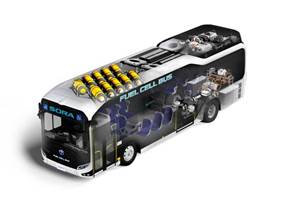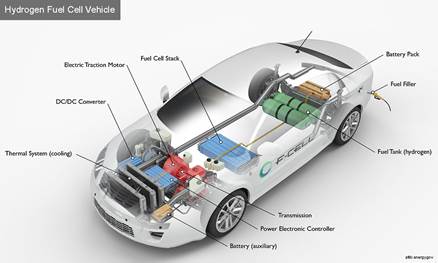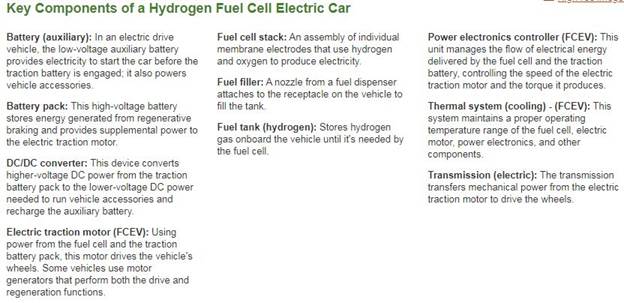Description

Disclaimer: Copyright infringement not intended.
Context
- Recently, India’s first truly indigenously developed Hydrogen Fuel Cell Bus developed by KPIT-CSIR in Pune was launched.
How Do Fuel Cell Electric Vehicles Work Using Hydrogen?
- Like all-electric vehicles, fuel cell electric vehicles (FCEVs) use electricity to power an electric motor. In contrast to other electric vehicles, FCEVs produce electricity using a fuel cell powered by hydrogen, rather than drawing electricity from only a battery.
- Hydrogen fuel cells like the one present in the bus produce electricity by combining hydrogen and oxygen atoms. The two gases react across an electrochemical cell similar to a conventional battery cell to produce electricity, water and small amounts of heat. This electricity is then used by electric motors to propel the vehicle forward.
- During the vehicle design process, the vehicle manufacturer defines the power of the vehicle by the size of the electric motor(s) that receives electric power from the appropriately sized fuel cell and battery combination. The amount of energy stored onboard is determined by the size of the hydrogen fuel tank. This is different from an all-electric vehicle, where the amount of power and energy available are both closely related to the battery's size.
- Thus, Fuel cell electric vehicles (FCEVs) are powered by hydrogen.

Advantages of Hydrogen Fuel Cell
- The primary advantage of hydrogen fuel cell electric vehicles (FCEV) is that they produce no tailpipe emissions. They only emit water vapour and warm air.
- Another advantage is that they are more efficient than internal combustion engine vehicles.
- Even with the fastest charging technologies, it could take hours to charge a battery-powered electric bus. Meanwhile, hydrogen can be refilled in a fuel cell vehicle in a matter of minutes, nearly as fast as an internal combustion engine can be refilled with fossil fuels.
- Other benefits include increasing energy resiliency through diversity and strengthening the economy.


FCEVs are not completely environment friendly
- One crucial point to note is that using a battery-powered electric vehicle doesn’t mean that the vehicles produce no emissions, but rather, that they produce no tailpipe emissions.
- Since a majority of the electricity in the country comes from fossil fuels, and the biggest source of hydrogen in the world currently is also fossil fuels, these vehicles do cause a large number of emissions with their usage.
- But just like we are moving towards renewable sources of electricity, we could also move towards renewable methods of generating hydrogen in the future. So even if these vehicles do contribute to emissions right now, the fuel that they need could be produced using renewable methods such as solar and wind energy.
Must Read: https://www.iasgyan.in/daily-current-affairs/green-hydrogen-fuel-cell-electric-vehicle
https://pib.gov.in/PressReleasePage.aspx?PRID=1853433













